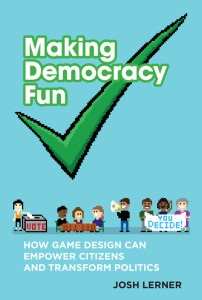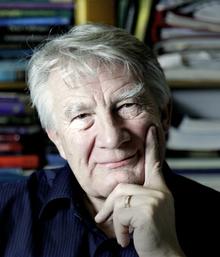Book Review: Making Democracy Fun: How Game Design can Empower Citizens and Transform Politics by Josh Lerner
Making Democracy Fun by Josh Lerner posits that public participation in decision-making can be enhanced by using games in public meetings, with the author drawing on multiple case studies of where this approach has been implemented. Ron Johnston finds a fascinating book that is as open about the dangers of game-playing as it is about the potential benefits, but suggests a more rigorous assessment of the evidence presented is necessary in order to make a final judgement on the value of games in democracy.

Can game-playing in public meetings improve the way people engage in decision-making? Credit: Julio Reis, CC BY-SA 2.5
Making Democracy Fun: How Game Design can Empower Citizens and Transform Politics. Josh Lerner. MIT Press. April 2014.
There is widespread concern throughout most of the world’s established democracies with disengagement from many aspects of political life – illustrated by, but far from confined to, turnout at general and other elections. Many ways of re-engaging those who have drifted into apathy, plus engaging the young, have been suggested, but there is little evidence of success. There tends to be more involvement on certain occasions – when a general election outcome is predicted to be close, for example – but the downward trend has not been halted. So how can greater involvement be encouraged? Josh Lerner believes it can be if democracy can be made fun for the participants, through well-designed game-playing; in that way, people will become more engaged and the increasing distrust in government that has generated/accompanied the decline in participation will be reversed.
Much depends, of course, on what is meant by game-playing and fun and after a brief introductory chapter setting his argument in the context of disengagement, disempowerment and distrust Lerner introduces the foundations of gaming. He believes that game designers can come to democracy’s rescue and in two lengthy chapters – ‘Games, play and democracy’ and ‘What game design can teach us about democracy’ – provides excellent, structured overviews of gaming (not game theory): these are interesting and valuable primers in themselves, separate from the arguments regarding democratic revival.
 The book’s next four chapters are case studies of the use of games in very different settings. The first three are reports of gaming situations that Lerner observed. The first two – ’Not just child’s play: games in democratic process’ reports on two programmes (‘The city of the children’ and ‘Theatre of the oppressed workshops’) in Rosario, Argentina; and ‘Rosario habitat; designing participation like a game’ reports on shanty town upgrading projects in the same city – are presented as a sequence: the former as illustrating how games can be introduced into meetings, without any specific reference to democracy; and the latter ‘how entire political processes can be designed to be more like games’ (p.120, his emphasis). The third chapter reports on participatory budgeting in the operations of Toronto Community Housing, and the fourth on a game that Lerner designed and oversaw in the same context, designed to evaluate and improve the participatory budgeting program there.
The book’s next four chapters are case studies of the use of games in very different settings. The first three are reports of gaming situations that Lerner observed. The first two – ’Not just child’s play: games in democratic process’ reports on two programmes (‘The city of the children’ and ‘Theatre of the oppressed workshops’) in Rosario, Argentina; and ‘Rosario habitat; designing participation like a game’ reports on shanty town upgrading projects in the same city – are presented as a sequence: the former as illustrating how games can be introduced into meetings, without any specific reference to democracy; and the latter ‘how entire political processes can be designed to be more like games’ (p.120, his emphasis). The third chapter reports on participatory budgeting in the operations of Toronto Community Housing, and the fourth on a game that Lerner designed and oversaw in the same context, designed to evaluate and improve the participatory budgeting program there.
As case studies these have considerable interest and fascination, particularly since they are presented in a ‘warts-and-all’ narrative which points to the problems as much as to the successes. But there is no deep evaluation, no assessment of not only the immediate outcomes of the individual projects – was the upgrading of the Rosario shanty towns not only ‘successful’, on whatever criteria might be deployed, but also ‘more successful’ than schemes elsewhere in the city where there was no gaming and the associated public participation? And were there spillovers? As a consequence of the schemes and games, did more people become involved in local political activity; did those involved in the games become promoters of democratic participation; did they feel more empowered as a consequence of their participation and become more trustful of governments; were they more likely to vote at elections…? Experiments are most valuable when they are rigorously assessed – which means that the evaluation programme must be part of the original design. The Toronto participatory budgeting projects clearly displayed some success on their own, internal, terms, but was democracy as a whole in the city improved? Lerner makes some honest, brief qualitative judgements on his own game (p.187), but that is all.
The concluding chapter is entitled ‘A toolbox for fixing democracy’ (there is no question mark at the end!). He presents a typology of games (animation, team-building, capacity-building, analysis, and decision-making), a discussion of four necessary design tools for any game (conflict and collaboration; rules; outcomes; and engagement), and outlines five ‘lurking dangers’ (violence; unfair outcomes; lack of fun; trivialization; and manipulation). These annotated lists will be of value for future game-designers as they address Lerner’s five ‘winning strategies’ – engage the senses; establish legitimate rules; generate collaborative competition; link participation to measureable outcomes; and design for participants. If they are deployed, he argues, then making democracy more enjoyable will boost citizen demand for engagement, deepen democratic power, and improve public trust in government.
Lerner is an enthusiast, but not a blinkered one: gaming may not make the world a better place – even at the local scale – and may do as much harm as good; games can mask or reinforce power inequalities, lead to unfair outcomes, be trivial and have no meaningful impact. Democracy is ‘not the most enticing pastime for most people’ (p.207) – too often boring, pointless, even painful. But done well, gaming can transform it, making it fun and generating a desire to be involved. For some it undoubtedly will, but will those who enjoy the games not only participate more in other situations (that might not address their own concerns) but stimulate others? The jury is out, and much depends on many more sharing Lerner’s enthusiastic optimism and willingness to work long and hard for the cause.
—
Note: This review was originally published on LSE Review of Books. it represents the views of the reviewer, and does not give the position of LSE or Democratic Audit. Please read our comments policy before responding. Shortlink for this post: bit.ly/1hbzheJ
—
 Ron Johnston is Professor of Geography at the University of Bristol. Ron’s academic work has focused on political geography (especially electoral studies), urban geography, and the history of human geography.
Ron Johnston is Professor of Geography at the University of Bristol. Ron’s academic work has focused on political geography (especially electoral studies), urban geography, and the history of human geography.





 Democratic Audit's core funding is provided by the Joseph Rowntree Charitable Trust. Additional funding is provided by the London School of Economics.
Democratic Audit's core funding is provided by the Joseph Rowntree Charitable Trust. Additional funding is provided by the London School of Economics.
Making democracy fun… impossible dream? https://t.co/sEGAbIR4Ei. Review of Josh Lerner’s new book on Democratic Audit
“@democraticaudit: Making democracy fun… impossible dream? https://t.co/JLWxVMJgZ7.” This book, I’m buying it. @HUURichard
Can you make democracy fun? We review Josh Lerner’s new book that says you can https://t.co/iKYPTREs6c
looks like a good, balanced account of the potential of game design and citizen engagement in public decision making https://t.co/y7fkKcWvNx
Book Review: Making Democracy Fun: How Game Design can Empower Citizens and Transform Politics by Josh Lerner https://t.co/P7hhSSygrh
The power of games: https://t.co/Pcks5euWmg
Book Review: Making Democracy Fun: How Game Design can Empower Citizens and Transform Politics by Josh Lerner https://t.co/VFTpe9qcBc